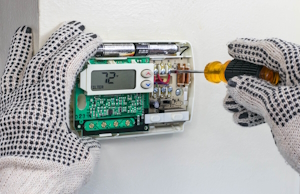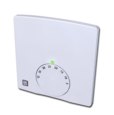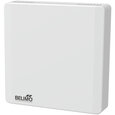HVAC Thermostat Troubleshooting & Repair

Figure 1: Thermostat repair can ensure the efficient function of an HVAC system
The thermostat is the control center for an HVAC system and should be the initial point of examination when a furnace does not start or frequently turns off and on. This article overviews how to troubleshoot an HVAC thermostat and repair or replace it if necessary.
Faulty thermostat symptoms
The following symptoms of a heating and cooling system may be symptoms of a bad hvac thermostat:
- Inaccurate temperature readings: If the temperature feels different from what the thermostat displays, the thermostat may need to be accurately sensing the temperature.
- Unresponsive HVAC system: The heating and cooling system does not respond to temperature changes on the thermostat.
- Short cycling: The HVAC system turns on and off more frequently than usual without reaching the desired temperature.
- Program settings fail to work: Modern thermostats make it easy to program schedules for heating and cooling. The thermostat may be the issue if these settings are not activating as expected or the hvac turns on when the thermostat is off.
- Thermostat display not working: If the thermostat does not turn on or respond to buttons being pressed, this may be due to dead batteries, a tripped breaker, or faulty wiring.
View our online selection of hvac thermostats!
HVAC thermostat troubleshooting
Use the following steps to troubleshoot an HVAC thermostat. Before working on one, however, turn off the power to the heating and cooling system to prevent an electrical accident.
-
Reset the thermostat
- Many digital thermostats have a reset function that can resolve software glitches. The reset procedure can vary, so refer to the thermostat's manual for specific instructions.
-
Check and replace batteries
- Many modern thermostats are battery-powered. If the display is blank or unresponsive, the first step is to replace the batteries. This simple step often resolves the issue.
-
Ensure proper placement
- The thermostat should not be placed near heat sources, such as sunlight, lamps, kitchen appliances, or in drafty areas. If it is, consider relocating the thermostat to a more suitable location where it can accurately read the room's temperature.
-
Clean the thermostat
- Dust and debris can accumulate inside the thermostat, affecting its functionality.
- Turn off the power to the thermostat at the breaker box to avoid electrical shock.
- Remove the cover of the thermostat. This usually can be done by gently pulling it off or removing screws.
- Use a soft brush or compressed air to gently remove dust from the inside.
- If there is any corrosion on the wiring terminals, carefully clean them with an electrical contact cleaner.
-
Check and tighten wiring connections
- Loose wiring can cause the thermostat to malfunction. After turning off the power, open the thermostat and inspect the wiring. Make sure each wire is firmly attached to its respective terminal.
- Tighten any loose connections with a screwdriver
- If wires appear corroded or damaged, they may need to be replaced.
-
Level mechanical thermostats
- Older mechanical thermostats need to be level to function correctly. Use a level tool to check and adjust it as necessary.
-
Calibrate the thermostat
- Some thermostats allow for calibration to ensure accurate temperature readings. Consult the manufacturer's instructions to see if this is possible with the model and how to do it.
How to replace a faulty thermostat
If the troubleshooting steps above do not solve HVAC thermostat problems, it may be necessary to replace the thermostat. Replacing a thermostat is a simple job that can be accomplished so long as care is taken to avoid accidents with electricity. The person replacing the thermostat should be able to unmount the old one from the wall, mount the new one, and wire the thermostat correctly. Learn more in our thermostat installation guide. Also read our thermostat types guide.
FAQs
How can you tell if your HVAC thermostat is bad?
If the heating and cooling systems are not responding to changes on the thermostat, troubleshoot the thermostat to determine if it can be fixed or needs to be replaced.
How do I reset my thermostat?
A digital HVAC thermostat can be reset by turning off the thermostat and resetting the circuit breaker. Review the thermostat's manufacturing guide to determine if it requires different steps.
Why is my HVAC thermostat not working?
Your HVAC thermostat may not work due to dead batteries, a tripped circuit breaker, faulty wiring, or it may need a reset.







